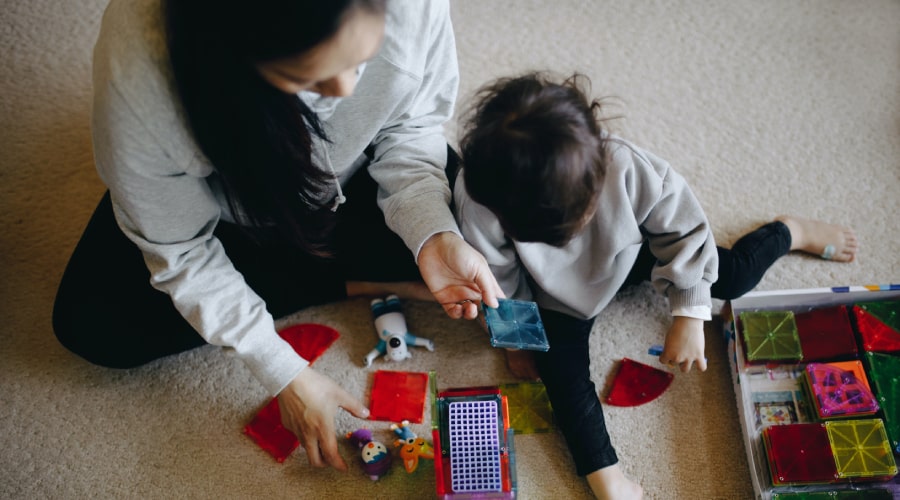settings
children
With Famly since
Picture this scene: You’re caring for a 6-month-old, and you’re watching her try to turn over from her back to her tummy. Each time she gives it a try, she gets stuck — she’s got her arm pinned, and can’t quite roll over it.
She’s laying on her back again, and gives it another go. Same problem.
Round three. She rocks back and forth, gets a bit of momentum going. Could this be it? Alas, that pesky little arm foils her plans once again. You get the feeling this could go on for hours, if you let it.
So when do you step in?
It’s tricky. If we let this baby go on all day we might get a pang of guilt, like we’re neglecting her. But if we step in too early, have we snuffed out a moment to build up her sense of autonomy?
There’s no simple answer here. But to understand the bigger picture of what’s going on in this moment, we can turn to the Pikler approach.
Put simply, it’s a pedagogy that puts a big emphasis on children’s ability to learn for themselves. But beyond that, it’s a way for caregivers to evaluate the bonds we share with children, and to better understand and respect each child as an individual. And once we can do that, it’s a lot easier to approach these moments of struggle and growth in early childhood.
Perhaps it’s not so much about this baby’s attempts to roll over, but about everything we do leading up to that moment.

What is the Pikler approach?
In the grand scheme of things, our idea of children as capable, independent people is relatively new.
Back in the early 1900s, a lot of popular ideas about raising children came from the theory of behaviorism. Essentially, behaviorism suggested that children didn’t learn much on their own. Instead, they were more like little lumps of clay, to be shaped by adults. Grown-ups had to teach children to do certain things, in a certain way, at a certain developmental stage — from sitting up and walking to saying please and thank you.
Dr. Emmi Pikler’s work took things in a different direction.
Born in Austro-Hungary in 1902, Dr. Pikler studied pediatric medicine during the 1920s and 30s, when behaviorism dominated Western countries’ approach to child development. After World War II she operated an orphanage in Budapest, known as Lóczy, where she began to apply her own approach toward how we raise and nurture young children.
In a nutshell, you could say the Pikler approach aims to create an early education environment defined by the following factors:
- Respect for children’s capabilities. Children are so much more than lumps of clay to be shaped. They’re intelligent, capable, curious individuals — and from birth, they deserve adults’ support and respect for how they grow and learn.
- Support, not intervention. A caregivers’ job isn’t to walk children through new skills. Rather, they trust the child to lead their learning, and give them the support and encouragement they need to build their own sense of competence.
- Emphasis on observation. Reflective, informed observation allows caregivers to understand each individual child’s strengths, needs and personalities.
- Unhurried time. Caregivers have the space in their day to share unhurried, one-on-one time with children, particularly during care moments like feeding and diaper changing.
In 2011, Lóczy reopened as a daycare center, now called the Pikler House. But those core principles are still there: At the Pikler House, things like resiliency and competency aren’t things you can force. Instead, you have to create the conditions for children to learn those skills on their own, and help them feel valued and supported enough to do so.
They’ve got a saying at the Pikler House: “The grass doesn’t grow better just because you pull at it.”
The big ideas

Why a trusting, close relationship must come first
Back to that core question: When we observe children struggling with a task, how do we know when to step in?
The best answer is, it depends.
Babies have got their own expressive nuances, just like us grown-ups. A scrunched-up face or a little gurgling noise might mean “I’ve got this” for one baby, or “I could use a bit of help” for another. To understand how to interpret these cues, you’ve simply got to know the baby as an individual. That’s why the Pikler approach puts so much emphasis on primary caregivers and unhurried time.
Rather than a teacher-child dynamic, you might think of it more like a cooperative partnership. You’ve got to trust infants’ ability to give things a go for themselves, and to signal when they’re ready for help. And they’ve got to feel safe and supported around you, so they trust you to recognize and respond to their signals.
The good news is, building this relationship is simpler than you might think. There isn’t some hidden technique hiding in a book you haven’t heard of. Rachel Tapping, Chair of the Pikler UK Association, explains that the biggest thing you can do is to trust children to tell you what they need, and do what feels right.
“What we need is to step back a bit — to stop trying to be and do everything, and instead just try to reconnect with who you are, and who this other person is,” she says. “That requires us to sit back and observe, and to notice what children are interested in.”

The Pikler approach in action
Let’s put all this into real-life terms. Suppose you’re watching that 6-month-old struggle to roll onto their tummy without getting their arm stuck. If you’re looking at this through a Pikler lens, what might you do?
First, let’s just observe. Take a minute to see how the child is trying to roll themselves, and exactly where and how they get stuck. Then, read their body language and signals, to see whether they seem engaged and motivated, or whether they’re getting frustrated.
After that, we can offer to get involved. You might try the three-step process called ISE: Invite, Suggest and Engage.
- Invite - Kneel down to their level and describe what you see, regardless of whether the child is verbal or not. “It looks to me like you’re struggling a bit, and your arm’s stuck. I could help if you like.”
- Suggest - Propose how you might help the child. “If you want, I can return you to your back. It'll be more comfortable, and you can try to roll over again if you want."
- Engage - Once you’ve received some invitation from the child — perhaps a shift in body language, a smile or a laugh — you can get involved, and help them as you’ve discussed.
Instead of simply flipping the child over, you might just put them a step back in their process, so they can reset and try again. This communicates that you’re attentive and present, but also that you believe in their own capability to meet their goal by themselves.
Mastering the art of doing nothing
Just as children want to learn, grown-ups feel compelled to teach. But sometimes, teaching means giving children the space and opportunity to explore things for themselves.
This can seem counterintuitive, because it’s quite easy to think we’ve always got to do something. But sometimes, the best learning comes from pausing, stepping back, and following the child’s lead.
Julia Manning-Morton, Secretary of the Pikler UK Association and an early childhood author and trainer, explains that being able to step back is something of a learned skill.
“Sometimes, groups like Ofsted or nursery managers can put pressure on practitioners to be seen as really actively involved with the children the whole time,” she says. “But that pressure can push us to impose on the children. As I like to say, ‘Don’t just do something — sit there.’”
But to be able to sit back and observe, we’ve got to build that close, trusting relationship with children first. That’s what gives them an emotional safety net, and the sense of support they need to experiment on their own. And, it’s what helps us understand these hands-off moments as valuable developmental opportunities, not neglect.
The better you know the child, the easier this becomes. Even if it feels unusual to begin with, Rachel Tapping says that learning to take a step back can help you build a whole new level of trust and understanding with the young ones in your care.
“When you really let a child achieve something on their own like that, you see that satisfaction on their face so clearly,” she says. “The feeling you get as the adult, especially if you had to sit on your hands to keep from intervening, is just beyond anything else. Just that one moment can set you on your own little high for the rest of the day.”

How do you communicate respect to an infant?
When you start reading up on the Pikler approach, you’ll often come across the idea of respecting infants.
At first glance, this might seem a bit confusing. If you’re working in early education, odds are you’ve already got plenty of respect and love for children.
But to understand what this means within the Pikler approach, it might be easiest to look at concrete examples: It’s about these small considerations that show infants that other people recognize their individuality, and they respect their needs and decisions.
Here are some ways the Pikler approach might have us show respect and consideration toward infants.
- Making sure every child has a primary caregiver, so that they’ve got someone with whom to build a strong, personal, reciprocal relationship
- Inviting infants to engage and give their approval before going ahead with interactions like cleaning, feeding, or intervening in their activities
- Offering infants more choice about what happens to them: “Will you take your socks off, or shall I?” or, “Would you like the diaper with the dinosaur pattern, or the hearts?”
- Trying to understand infants’ needs and intentions by the cues they give through their body language and gestures
- Slowing our interactions, so we have more time to observe and reflect on children’s interests and preferences during the time we spend with them
- Resisting the impulse to intervene in children’s activities too early — and giving them space and time to build their own strengths, and solve problems for themselves
To think about it another way, you might check out this questionnaire: How would you like it if some huge hands just plucked you up and wiped your nose without asking?
Building trust, one nappy change at a time
So for children to get the most out of those moments of struggle and problem-solving, we’ve got to create that safety net of a trusting, reciprocal relationship.
But that’s a pretty heady concept. How do we bring that onto the classroom floor?
The single most important thing you can do, according to Julia Manning-Morton, is to make more time each day for those routine moments of one-on-one care. This means events like:
- Nappy changes
- Washing
- Dressing
- Meal times
As she explains, these moments are key pedagogical learning experiences for you and your children. During these parts of your day, you’re sharing close, one-to-one intimate contact with children — and the way you engage with them has a real-life, lasting effect on how they understand your relationship, and their sense of self.
“When you handle a child, you tell them exactly what you think of them in the way you touch, hold and speak to them,” Julia says. “If we can make these moments positive and attentive, children have less need for adults during independent play and exploration, as they’ve fueled up on that sense of warmth and nurturing during these care events.”
To tie back into our initial question, knowing how (and when) to let children struggle isn’t only about how you act in the moment. It’s also about everything you do leading up to that point — so that when it’s time for the little ones to venture out and grapple with something new, they know they’ve got your safety net beneath them.
Top tips from Alphabet House
Get top tips from a setting just like yours. Hear from Alphabet House on why and how they use Famly - and why they’ve never looked back.
Read their story










